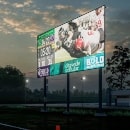How are OOH Audiences Measured?
For a long time, out-of-home (OOH) advertising was the most common form of advertising advertisers engaged in. This type of advertisement refers to any kind of advertising that happens outside of the home.
With an OOH ad or OOH campaign, you can reach a large target audience, via digital signage in a high traffic area. This kind of advertising can be as grand as a digital display off of a New York City highway, or as small as a billboard inside of an outdoor plaza. When you think of OOH advertising, think of Times Square, covered in billboards with splashy, impactful ads. All of the digital displays you see there are forms of OOH advertising.
In the age of social media and online advertising, this method is sometimes seen as outdated. However, outdoor advertising is a great way for any advertiser or marketers to increase brand awareness and reach their consumers. These ads can have a wide-sweeping reach, being seen by thousands of commuters a day.
Unfortunately, the downfall of this type of marketing is how difficult it is to gain audience data and audience measurement, to see the true impact of your advertising campaign. Though we know OOH ads can be beneficial, it’s not easy to determine specific metrics in terms of viewership and influence.
How do we know people are actually paying attention to the roadside billboards, bulletins, posters, and other types of OOH available? And where should you look if you need accurate OOH metrics for your OOH ads? Let's take a look.
Related: How Digital Out of Home Advertising Helps Your Business Geotarget Customers
History of OOH Advertising
Measurement of audience impression for an OOH campaign used to be simple, according to JCDecaux North America. Daily Effective Circulations (DECs) reported the number of times in a day an out-of-home display was passed by a person over the age of 18, helping an OOH advertiser determine the ad's audience size.
Though this process was straightforward, this information didn't actually reflect the impact of an ad. This number doesn't account for the fact that not every person passing an ad looks at it. It also doesn't account for people under 18, who still influence purchasing decisions.
Because of this, traditional OOH advertisers needed to find new ways to gain a better understanding of their audience, so they could adjust ad campaign planning to impact their desired audience.
A New Method
In 1933, the Traffic Audit Bureau for Media Measurement Inc. (TAB) was formed. The purpose of this non-profit organization is to measure out-of-home advertisement circulation in the United States and conduct other studies related to OOH media.
TAB now offers a measurement system to all members based on extensive research conducted by the organization. For better audience insight Called TAB Out of Home Ratings, the TAB website says these measurements for each display include:
- Audiences for OOH advertisements
- Geographic reach and frequency
- Demographic data that is higher in detail
- Commercial ratings based on number of people who view an ad
To see the points measured by TAB and how the data is generated, look at this infographic. They include data points like:
- The total number of people expected to pass a display each day
- Demographics of people most likely to pass
- The position of the display in relation to the roadway
- Speeds of passing vehicles
- How many ads are rotating on each display, and how long each ad is shown
Moving Forward
In the future, we may even be able to use the OOH displays themselves to measure an OOH audience. Digital billboards and displays with facial recognition that can tell when the board is being viewed already exist. Many displays are also going interactive. This type of technology may one day be plugged into all digital displays to give us these numbers.
As technology develops and OOH advertising is integrated into even more devices, how we measure audiences will continue to change. For now we thankfully have TAB ratings to tell us what we need to know about our audiences.










